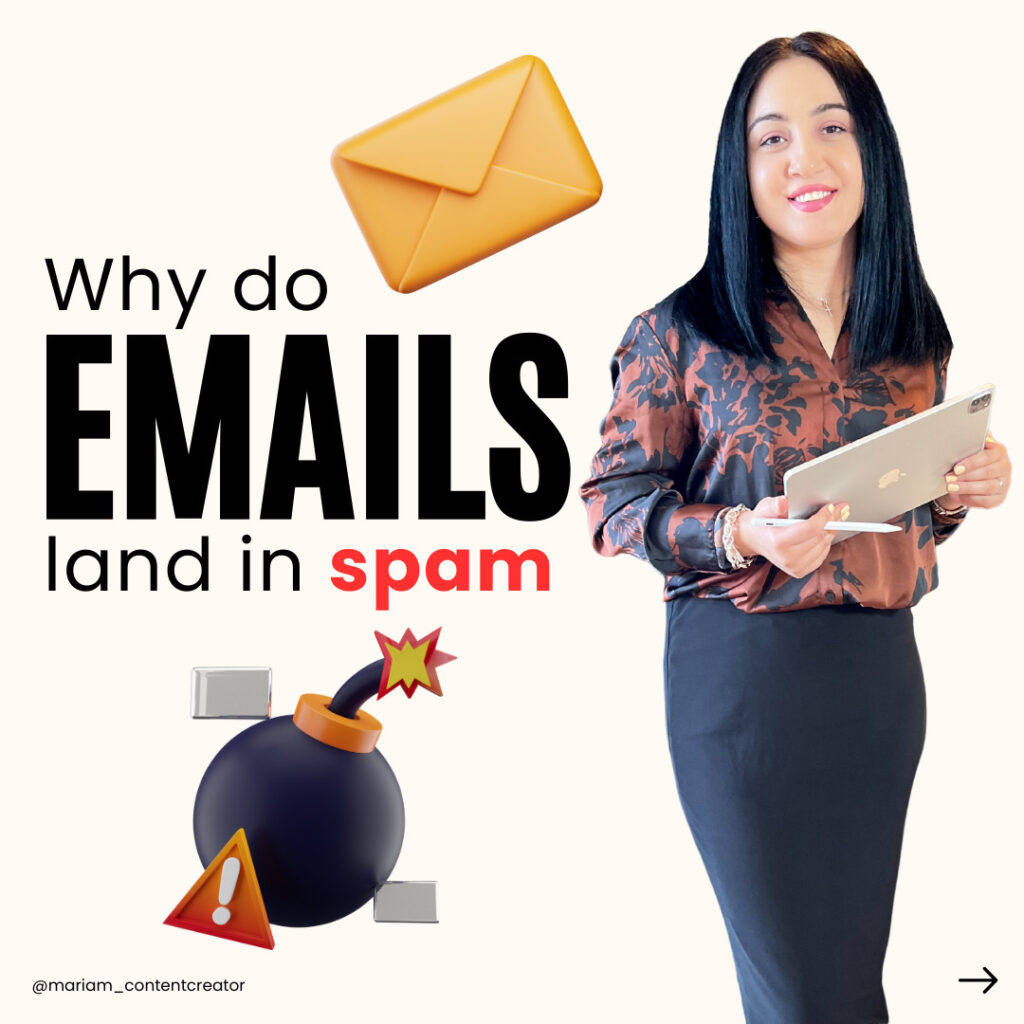A Simple Guide to Avoiding Email Spam Triggers | Email Marketing
In today’s digital world, email marketing is still a key part of business communication and marketing. But there’s a problem that can make it less effective – the feared spam folder. It’s a place where marketing efforts can vanish without anyone noticing. It’s important to know and avoid the things that cause emails to go to spam, so your message actually gets to your audience. This guide explains these things in detail, helping you to make sure your emails end up in the right place – the inbox.

The Risks of the Subject Line
1. Misleading Phrases: Using phrases like “Re:” or “Fwd:” to mimic ongoing conversations may seem clever, but it’s a surefire way to trigger spam filters. Instead, strive for genuine, intriguing subject lines that accurately reflect your email’s content.
2. ALL CAPS: ALL CAPS can come across as shouting in the digital world. It’s not only a turn-off for readers but also a red flag for spam filters. A well-crafted subject line in regular case can be just as, if not more, effective.
3. Excessive Punctuation: Enthusiasm is great, but overdoing it with exclamation points (e.g., “Buy now!!!”) can be perceived as aggressive or spammy. A single exclamation point or even a well-placed question mark can often do the trick.
4. Spammy Words: Words like “Free”, “Guaranteed”, “Congratulations”, “Risk-free”, and “Winner” are overused in spam emails. They’re likely to get your email filtered out, so opt for less ‘spammy’ vocabulary.
Content Triggers and How to Avoid Them
- Overuse of Colors and Fonts: A hodgepodge of fonts and a rainbow of colors can be visually overwhelming and trigger spam filters. Stick to a clean, professional design for your emails.
- Misleading Content: Nothing damages a brand’s credibility like dishonest content. Avoid clickbait and ensure that your email’s content is transparent and relevant to your audience.
- Link Shorteners: Though they save space, shortened URLs can be suspicious because they mask the final destination. Use full URLs where possible to ensure your emails don’t look deceptive.
- Image-to-Text Ratio: Emails that are heavily image-based with little text can raise spam flags. Balance is key – combine visuals and text to create an engaging yet filter-friendly email.
Technical Triggers – What to Watch For
1. Attachments: Attachments, especially executable files (.exe, .zip, .swf), can be red flags for malware and trigger spam filters. If you need to share a file, consider using a trusted file-sharing service and provide a link in your email.
2. Low Engagement Rates: If your emails consistently go unopened or are immediately deleted, this can harm your sender reputation. Focus on creating engaging, relevant content to boost open and read rates.
3. Sending Domain Reputation: Your sending domain’s history plays a significant role in deliverability. If your domain has been used for spam in the past, it could be blacklisted. Regularly monitor your domain’s reputation to avoid issues.
4. Missing ‘Unsubscribe’ Link: Including an easy way to unsubscribe is not just courteous – it’s a legal requirement in many places. A clear unsubscribe link helps avoid spam flags and respects recipient preferences.
5. HTML Issues: Poorly coded HTML can lead to rendering issues and spam flags. Ensure that your email’s HTML is clean and standard-compliant.
Behavioral Triggers – Sending Practices to Refine
Your email sending behavior plays a vital role in how filters perceive and handle your messages. Understanding and implementing certain strategies can help improve the deliverability and effectiveness of your email campaigns. Here are some specific considerations:
1. Sending Frequency: Bombarding subscribers with an excessive number of emails is a common mistake that can lead to unsubscribes and a poor user experience. Instead, find a balanced sending frequency that keeps your audience engaged without overwhelming them. Consider the preferences and expectations of your subscribers and aim to strike a harmonious balance between staying top-of-mind and avoiding inbox fatigue.
2. Irregular Send Patterns: Consistency is key in email marketing. While it’s important to find the right frequency, it’s equally important to maintain a regular sending pattern. Erratic blasts of emails following a period of silence can give the impression of spam or suspicious activity. Develop a consistent schedule for sending your emails and stick to it. This builds trust with your subscribers and ensures that they anticipate and recognize your emails as legitimate and relevant.
3. High Bounce Rates: Sending emails to non-existent or inactive email addresses can have a negative impact on your sender reputation. When you have a high bounce rate, filters may interpret it as an indicator of poor list hygiene or disengaged recipients. Regularly clean your email list by removing invalid or inactive email addresses to maintain a healthy sender profile and minimize the chances of your messages being marked as spam.
By being mindful of these factors, you can enhance the deliverability of your emails, improve engagement with your audience, and maintain a positive sender reputation. Remember, establishing a strong and trustworthy relationship with your subscribers is key to the success of your email marketing efforts.
Authentication Issues – Securing Your Email’s Integrity
Ensuring your emails are properly authenticated can significantly reduce the likelihood of being flagged as spam. Implementing proper authentication measures is crucial for maintaining the integrity of your email communications.
One of the most important authentication techniques is SPF (Sender Policy Framework). SPF allows the recipient’s mail server to verify that the incoming email is indeed sent from an authorized IP address for the sending domain. By publishing SPF records in your DNS configuration, you can specify which IP addresses are allowed to send emails on behalf of your domain. This helps prevent spammers from forging emails with your domain name, reducing the likelihood of your legitimate emails being marked as spam.
Another essential authentication method is DKIM (DomainKeys Identified Mail). DKIM adds a digital signature to your emails, allowing the recipient’s mail server to verify the authenticity of the message. It works by generating a unique cryptographic key pair for your domain. The private key is used to sign outgoing emails, while the public key is published in your DNS records. When the recipient’s server receives the email, it can use the public key to verify the digital signature and ensure that the email hasn’t been tampered with during transmission.
In addition to SPF and DKIM, implementing DMARC (Domain-based Message Authentication, Reporting, and Conformance) is also crucial. DMARC builds upon SPF and DKIM by providing an additional layer of protection and control. It allows you to specify how receiving email servers should handle unauthenticated emails from your domain. With DMARC, you can choose to monitor, quarantine, or reject emails that fail authentication. By regularly monitoring DMARC reports and ensuring compliance with DMARC policies, you can enhance the deliverability of your emails and reduce the chance of them being flagged as fraudulent or spam.
To summarize, implementing SPF, DKIM, and DMARC is essential for ensuring proper email authentication and reducing the likelihood of your emails being marked as spam. It is important to regularly monitor these technologies, update your DNS settings accordingly, and comply with DMARC policies to maintain the integrity and deliverability of your email communications.
Additional Factors to Consider
I apologize for the brevity of my previous response. Let me expand on the topic of email best practices for you.
- Broken Links: It is crucial to ensure that all links in your email are functional. Broken links not only harm the user experience but can also have negative consequences, such as having your email flagged as spam. To avoid this, make it a habit to regularly test and verify all the links included in your emails. Double-checking the URLs, ensuring they are correct, and validating that they lead to the intended destination will greatly enhance your email communication.
- Using Spam Traps: In order to maintain a healthy email delivery rate, it is essential to avoid sending emails to addresses that are used by organizations as spam traps. These spam traps are designed to catch spammers and sending emails to them can harm your sender reputation. These addresses are often created solely for the purpose of identifying unsolicited emails, and they have never been used for legitimate sign-ups. To prevent getting caught in these traps, it is recommended to practice regular list cleaning and regularly update your subscription practices. Removing inactive or unengaged subscribers from your list, ensuring that your opt-in process is permission-based, and regularly reviewing and updating your email list will help you maintain a positive reputation in the eyes of email service providers.
Conclusion
Email marketing is an intricate process that requires a careful balance of many elements. The main challenge is navigating around the various spam triggers to ensure your messages are successfully delivered to their intended recipients. This isn’t a straightforward task. It requires a blend of creative intuition and precise scientific methods, as every decision can potentially lead to progress or setback. Therefore, it’s essential to stay vigilant about these triggers and manage them effectively to increase the chances of your emails landing in the right inboxes.
The digital landscape, especially in the realm of emails, is in a constant state of flux. New rules and restrictions are being implemented as quickly as old ones are discarded. In light of this, it’s not sufficient to merely chart a course and rigidly stick to it. The need of the hour is to remain flexible and agile, ready to adapt to the shifting sands of the digital space at a moment’s notice. To facilitate this, it’s advisable to regularly test and refine your strategies. Tools such as MailTester can prove to be invaluable allies in this journey, aiding you in staying ahead of the curve and maximizing your delivery rates.
However, it’s essential to bear in mind that successful email marketing isn’t defined solely by the ability to sidestep spam filters. The ultimate objective is to establish a meaningful connection with your audience. This requires engaging them in a manner that aligns with their needs and interests. Achieving this demands not just technical proficiency but a profound understanding of your audience and a genuine desire to provide them with value. If you can keep your focus on this aspect, you can develop an email marketing strategy that not only reaches its destination but also leaves a lasting impact, resonating deeply with your audience.

